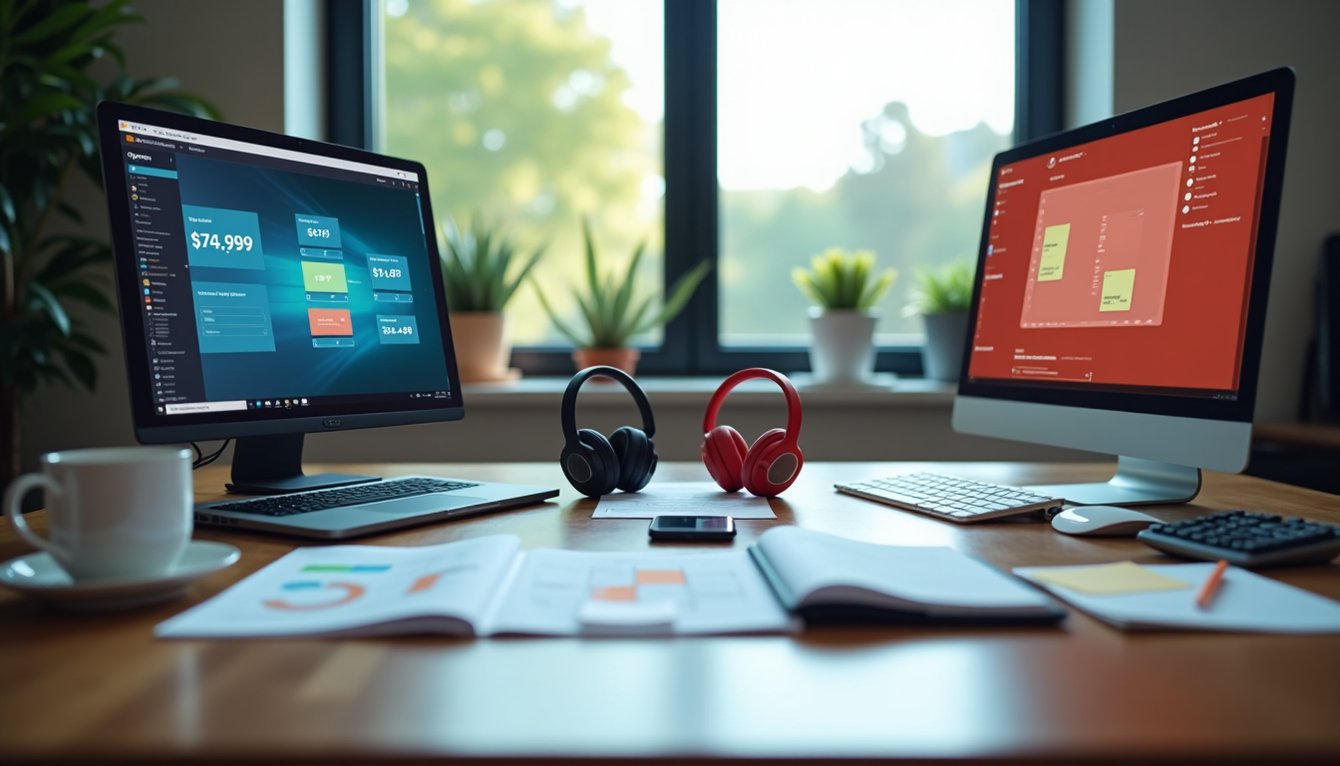Are your private label products over (or under) priced? Hidde Roeloffs Valk, Solution Consultant at Omnia, explains how a reference pricing strategy helps you optimize your private label products and keep them at market-level prices.
|
[00:00:10.590] - Grace |
Hello and welcome to price points. The podcast examines the changing world of e-commerce. One episode at a time. I'm your host Grace Baldwin. And today we're talking about strategy more specifically we're going to talk about reference pricing. So a few weeks ago we published a blog post about reference pricing but since it's such a fascinating topic I also wanted to do a show about it to me reference pricing is a blindingly simple solution to a problem that a ton of retailers face. It's one of the solutions that's so simple it's no wonder that nobody really thinks of doing it. In short reference pricing is a great strategy for any retailer who makes a private label product and wants that product to be competitive on the market. Traditionally stores haven't been able to use dynamic pricing on products like these because the G10 for that product doesn't exist beyond that store. Reference pricing makes it possible though with a simple three step process First you need to find a product that's similar to your own to serve as a reference point. Second you need to determine the relationship you want to have with that reference product. Third you need to put the G for both products and that relationship in the form of a business rule into your dynamic pricing system. And let the tool take care of the market pricing. So see what I mean when I say it's actually pretty simple. I sat down with the author of the blog, Hidde Roeloffs Valk, one of our solution consultants here. If you listen to the podcast for a while you've already met Hidde. But if not know that he is obsessed with anything to do with pricing and is exceptionally passionate about his work. You can learn more about him in price points Episode 2 and I'll include the link to his post in the shownotes. In this conversation we talked more about reference pricing, where the idea came from, what kinds of categories it works best for and more. So please sit back and enjoy this episode. I think you're going to like it. Thank you for joining me again about this |
|
[00:02:09.950] - Hidde |
No problem. |
|
[00:02:10.660] - Grace |
And so yeah. Again I want to talk today about reference pricing. So we've talked about this in the past and you wrote a blog post about it. And I'm just curious. So what exactly is reference pricing and why would a company actually want to use this strategy? |
|
[00:02:29.180] - Hidde |
There's a challenge within retail or basically in pricing where no products are directly comparable and there's companies that want to have a pricing set based on their competitors. That's also in a previous blog post competitor based pricing fairly commonly used. It's easy to, use it's simple. You just need the data and the tool, obviously. But let's say I'm selling a Samsung TV as a retailer. It's easy to match that Samsung TV one to one like apples to apples to the same Samsung TV sold at another retailer. So that's competitor based pricing in a very short sense But what if you sell your own products or have products that can't be matched, can't be compared in a one to one comparison. Then what can you do? You need different data points to steer on, to base your price on, and one of those is reference pricing. So what you do is basically for a product that's hard to compare, you make it comparable. You refer the price of one product to the price of another product that's not directly comparable. In short that's reference pricing it's used a lot in private label products for instance but can also be used in matchable products or unmatched products, but for private label it's it's a very good one because it also places you in terms of value in a relative distance towards known products. Let's say I'm making my own TV. I know, yeah quality is about 20 percent difference or 20 percent less then I'd like my price also to be 20 percent less than a famous Samsung TV for instance. So I'd refer both in quality and in price towards other other products and thereby making it comparable. |
|
[00:04:29.120] - Grace |
And so by that you mean so you take the GTIN of your product and then you do it within the system you reference it to the GTIN of another product that's sort of comparable. |
|
[00:04:38.660] - Hidde |
Exactly. So there's some manual work involved there's no algorithm that I know of that can do this for you. There's a lot of factors at play. Buyers and category managers are really the product experts in this and you need their opinion on this. I don't think data scientists know the products very well they know the data very well and there's so much subjective about the quality of a product that this cannot be captured currently in algorithms in my opinion. So there's some manual work at the start involved. Every product that you want to apply reference pricing to needs to be linked to another product. But however it is applied at some of the retailers I know and they've had great results because in the end if you're selling private label products your margins are often higher there. But people forget that the price is relative. |
|
[00:05:33.290] - Grace |
Some people you mean by people you mean within the retailers or you mean consumers. |
|
[00:05:39.410] - Hidde |
Yeah consumers don't forget it. Consumers shop around they shop for advices they Google reviews and in these reviews sometimes it's referred like, "Hey, this product is better than product X," and that's kind of stuff. So why wouldn't you refer to price then towards that product. So yeah it's it's they would be the people would be buyers and category managers that would set they are experts and hopefully in accordance with the pricing manager ideally. |
|
[00:06:12.880] - Grace |
And then I think another thing that's maybe worth touching upon is what do you how did you come into reference pricing? |
|
[00:06:20.010] - Hidde |
It's basically an idea I had about three years ago working with the first pricing implementations here at Omnia. And it. Yeah. I said earlier it combines value based pricing which I did often at my previous company and competitor based pricing where Omnia is of course an expert in, and this finally combines those two worlds. I've advised multiple clients but since this year some clients have done it and that that has made us quite enthusiastic about it because their results were great. We can't disclose any numbers about that but they were really really happy about both revenue and margin impacts. |
|
[00:07:03.170] - Grace |
So like if you had to give a scale of 1 to 10 and happiness where would you put them? |
|
[00:07:09.480] - Hidde |
An 8. Yeah yeah. |
|
[00:07:11.950] - Grace |
And did they, did they come up with this independently or was it something you advised. |
|
[00:07:16.070] - Hidde |
The interesting part was they came up with this independently. So we didn't even advise it. We sometimes mention it in meetings but it's not something standard. We only mentioned it when we feel that is needed to mention it as it's quite an advanced really advance dynamic pricing strategy and it does take some time where people first want to focus on getting their grasp on dynamic pricing. But I think if you're really searching for a next phase target in dynamic pricing this would be something really ideal. Or if you're struggling with your own brand products and really having to question how do I price them what what can I do or what should I do. It might be an ideal strategy if you're having a hard time selling those basically and it's low risk because you have a lot of margin left if set up correctly you can take it within small phases and not have a huge price distance yet. So with the right guidance the right tools yeah, it will have no negative impact on on your margins. |
|
[00:08:26.680] - Grace |
Is this a common practice already? |
|
[00:08:29.650] - Hidde |
It's not really common. So I think there's multiple retailers that can benefit a lot from this, doing it on the short term as not a lot of retailers do it. So you have quite some advantage over there. It does take some time but it can be, as a margin optimizing strategy, I think it can be really really helpful. |
|
[00:08:50.260] - Grace |
And it just it really takes more time in the beginning right. And then once you have it set up it's pretty easy to manage as any other dynamic pricing strategy. |
|
[00:08:59.110] - Hidde |
Exactly. So this reference pricing in general is not something that's standardly available within pricing tools as it's very customer specific. Also the tactics around it are customer specific. Am I gonna refer to one or more products? Which products? And how do I implement that? On which which frequency do I want to update those prices? Those are very very customer specific but in the end the rules can be made fairly simple you just need quite some data and quite some qualitative analysis from the experts. |
|
[00:09:37.950] - Grace |
The experts being the Category Managers and Buying Managers. |
|
[00:09:41.390] - Hidde |
Yes exactly. So it's working together of both maybe even data scientists pricing managers and the buyers and category manager who know the products and the market more than than anyone. So yeah and that's interesting to see. |
|
[00:09:56.690] - Grace |
What sort of products does this work well for? So we've talked about and the example you used in the blog post was about light bulbs. Are there any categories that this is especially useful for? And are there categories where it's not useful? |
|
[00:10:12.310] - Hidde |
I would say categories with, where people do extensive research. It's really really powerful because they're, the consumer's more aware of these differences and it's more transparent. So in lighting one light bulb might not be a huge purchase but in this particular example these are purchases where a company buys a thousand light bulbs and then these price differences add up. And then you look for quality differences perhaps and then these these things pop up. But I would say more expensive products where it definitely matters more for food people agree that it's just less quality and that's more fast moving so I would say for slow moving consumer goods as this works really very well. Of course it can work for both ends but I think the impact is higher. What I see across Europe is with more expensive products |
|
[00:11:10.250] - Grace |
More expensive slow moving consumer goods. |
|
[00:11:12.650] - Hidde |
Yeah. |
|
[00:11:13.030] - Grace |
Can you reference more than one product at a time. Or does that have to be one. So if I have my computer here can I also reference it to a Macbook and then also to a Samsung computer or do I have only pick one of the two? |
|
[00:11:27.300] - Hidde |
No definitely there is multiple ways to go around it. And I've seen different stuff. It's it's more of a tactic really and the implementation that you apply towards it. For instance you could map it to words several products and maybe take the highest or the lowest depending on that day's information that you have or maybe the most popular one according to some data. So yeah if you make if you have the data and you make a choice then you can automate that within your reference pricing strategy definitely. |
|
[00:12:01.410] - Grace |
So you can say okay I want to be between computer X and computer Z? Like I want to be exactly... |
|
[00:12:08.190] - Hidde |
Exactly, that can also be done. In theory you could also take the average of those three or maybe 10 percent of that and 20 percent of that. |
|
[00:12:17.760] - Grace |
It's a value gap analysis is the term correct. Determining okay. My I want to be price X compared to Competitor A. Like I want the price difference to be 20 percent. How do you actually go about building this analysis and determining this gap? |
|
[00:12:34.770] - Hidde |
So one way to look at it and that's some of my my previous work at Simon Kucher. Where they do lots of projects about value based pricing. And basically reference pricing is, in my opinion, one of the few pricing methods where you combine both. |
|
[00:12:50.520] - Grace |
So just to clarify at this point when Hidde says "both" he's referring to both value based pricing and competitor based pricing. |
|
[00:12:58.300] - Hidde |
And value based pricing starts off then with mapping out your assortment based on some characteristics. So first you look at what are the most important characteristics according to to consumers or consumer segment that I'm looking at. I would order those and maybe take the first five and order my product categories within value of those characteristics. For example something fairly simple a TV Samsung sells three TVs of the same product type for instance but it has a 50 inch screen, a 60 inch screen and 70 inch screens. Those are characteristics so you can already map out the value the 70-inch screens of course worth more than a 50-inch screen. So in that way you already see as sort of value map within your own product assortment and then it's key that for every step in that value map you can have a reference products where you'd say OK that 70 inch TV needs to link towards a 70-inch TV of a competitor. |
|
[00:14:06.170] - Grace |
OK. So you're just basically you just rank it sort of what consumers care about most. |
|
[00:14:11.770] - Hidde |
Yeah. And that would be the way to go. But in the end you need to do one to one pricing so you map out the most important characteristics and you'd look for those characteristics at a relative products and then refer to those in price so maybe the 70 inch TV screen of my competitor is made of plastic and mine is made of glass. Well that would be in my opinion a 10 percent price difference for instance according to the to the expert. |
|
[00:14:41.100] - Grace |
So you come up with this 10 percent and that's just based off of kind of you know the two materials and where you're where your commercial objective is and what you want your pricing perception to be. |
|
[00:14:50.190] - Hidde |
Ideally this would be based on a consumer willingness to pay. And that's the value that we're searching for. So whatever value the consumer attaches to it you want to to optimize margins optimize revenue. You want to "exploit" between brackets. Yeah between quote marks. Actually you want to exploit that and use that to maximize the pricing. Or just take the relative price distance. Yeah. Depends a bit on the situation of course. |
|
[00:15:19.350] - Grace |
This gets into a little bit into price perception. And so if you're a company and you're creating a lot of private label own label things. But the quality. So how do you manage your price perception if the qualities of say you make TV but also candles you're a big sort of overall retailer and the quality of TV is is lower than your reference product but the quality of like your candles are higher than whatever you're referencing. How does how do you manage that price perception? |
|
[00:15:50.040] - Hidde |
Well what you could have is those private label brands can have other names so maybe you're selling the private label really under your own name but selling the candles under a different name which has more of a premium feel and look to it. So that that's one way to manage it but also of course in terms of pricing. But ideally in pricing consumers get a feeling attached toward a certain brand. Same example of it in the car industry, you have Volkswagen and BMW everybody knows BMW is more expensive, more quality, high quality and Volkswagen is less expensive. So that's very deliberately done. And the same should be done by brands. It also fits into your marketing strategy your customer service et cetera et cetera. |
|
[00:16:41.540] - Grace |
Yeah. So it's really more of a it's a broad thing. |
|
[00:16:43.850] - Hidde |
Exactly. That you and you have. You have to consider a lot of different elements of it exactly as is as is known of course and pricing it touches so many subjects. That's why it also makes it a very interesting topic for people to work in. |
|
[00:16:56.310] - Grace |
And what are some KPI is that people can use to measure the effectiveness of this strategy? |
|
[00:17:01.530] - Hidde |
It depends a bit on seasonality but you can always take year year analysis of your own brands. You can check the cannibalization so what if I change the price of this products. Does it hurt the reference price product. So that's one thing to look at but as a standard we always advise to take into account year on year revenue volume and margin next to that. You can do some quantitative analysis asking your consumers what what their price perception is currently. So yeah on a regular basis asking your consumers for feedback. I don't think that's a that's something bad. And you know take the price perception for that into account. |
|
[00:17:42.230] - Grace |
And so do you have any tips for it. So if somebody wants to just get started with this what would you what would be? |
|
[00:17:48.120] - Hidde |
Step 1 start simple with just a few products and get the process working and get some initial results in fast. Because if you want to start with too many products you'd get lost and maybe the implementation then doesn't work and you don't know why the implementation because there's so many products involved. |
|
[00:18:09.770] - Grace |
Would you recommend starting with your high runner products or late or long tail? |
|
[00:18:13.790] - Hidde |
I would say long tail because they're probably not priced correctly. So yeah my advice would also always be to start fast as every day in pricing that you're not on your ideal strategy is day loss often in revenue and margin. |
|
[00:18:31.490] - Grace |
Anything else that you want to communicate about reference pricing? |
|
[00:18:34.520] - Hidde |
Anyone interested in this reference pricing can contact us and we'll be happy to help you set this up. |
|
[00:18:42.170] - Grace |
Perfect and if they if anybody has questions they can just send you an email or Linkedin, right? |
|
[00:18:46.130] - Hidde |
Yeah. Drop me an email. That's perfectly fine. |
|
[00:18:49.060] - Grace |
Perfect. All right. Well thank you so much. This has been really helpful and enlightening. |
|
[00:18:56.550] - Grace |
Thanks again for listening to PricePoints. I really hope you enjoyed this interview with Hidde. If you'd like to learn more about reference pricing check out the blog titled How Reference Pricing Keeps Your Private Label Products Agile on our website. If you'd like to get in touch with Hidde, feel free to reach out to him at Hidde@Omniaretail.com or by LinkedIn. You can also reach out to me at the same channels and my email is grace@omniaretail.com all the contact details as well as the blog post link are in the show notes. In the meantime though I hope you have an excellent rest of your day. |
SHOW NOTES:
Omnia was founded in 2015 with one goal in mind: to help retailers take care of their assortments and grow profitably with technology. Today, our full suite of automation tools help retailers save time on tedious work, take control of retail their assortment, and build more profitable pricing and marketing strategies. Omnia serves more than 100 leading retailers, including Decathlon, Tennis Point, Bol.com, Wehkamp, de Bijenkorf, and Feelunique. For her clients, Omnia scans and analyzes more than 500 million price points and makes more than 7 million price adjustments daily.
Music: "Little Wolf" courtesy of Wistia
TO CONTACT HIDDE ROELOFFS VALK:
Email: hidde@omniaretail.com
LinkedIn: Visit here
TO CONTACT GRACE BALDWIN:
Email: grace@omniaretail.com
LinkedIn: Visit here





